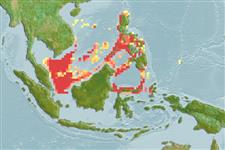>
Acanthuriformes (Surgeonfishes) >
Lobotidae (Tripletails)
Etymology: Hapalogenys: Greek, hapalos = soft * Greek, geny, -yos = face (Ref. 45335); filamentosus: The specific name refers to the filamentous first ray of the pelvic fin of this species.
Environment: milieu / climate zone / depth range / distribution range
экология
морской донно-пелагический; пределы глубины 30 - 80 m (Ref. 76777). Tropical
Western Central Pacific: off Iloilo Panay Island, Philippines.
Size / Вес / Возраст
Maturity: Lm ? range ? - ? cm
Max length : 14.9 cm SL самец/пол неопределен; (Ref. 76777)
Краткое описание
определительные ключи | морфология | морфометрия
колючие лучи спинного плавника (общее число) : 11; членистые (мягкие) лучи спинного плавника (общее число) : 14; колючие лучи анального плавника: 3; членистые (мягкие) лучи анального плавника: 9. Distinguished from other congeners by the following combination of characters: lower lip fleshy with dense cluster of very short papillae, scaly posteriorly (on posterior abdominal part of angular of lower jaws); presence of 10 unobstructed pores on and behind chin; maxilla without scales; body with 2 faint longitudinal dark stripes, 1st from nape to base of mid dorsal-fin soft rays, 2nd from eye to base of last dorsal-fin soft ray, their width below base of 5th and 6th dorsal-fin spines clearly narrower than pupil diameter in 6.5-15.8 cm SL; soft rayed portions of dorsal and anal fins somewhat rounded posteriorly and slightly angulated posteriorly, respectively; pelvic-fin tip almost reaching to or slightly beyond base of 1st anal-fin spine when depressed; pored lateral-line scales 41 or 42; a procumbent spine-like process (exposed tip of 1st pterygiophore) apparent at origin of dorsal fin but covered by predorsal scales (Ref. 76777).
The habitat is likely to be dominated by a muddy rocky bottom (Ref. 76777).
Life cycle and mating behavior
половая зрелость | размножение | нерест | икра | Fecundity | личинки
Iwatsuki, Y. and B.C. Russell, 2006. Revision of the genus Hapalogenys (Teleostei: Perciformes) with two new species from the Indo-West Pacific. Mem. Mus. Victoria 63(1):29-46. (Ref. 76777)
Статус Красного Списка МСОП (Ref. 130435: Version 2024-2)
Использование человеком
дополнительная информация
инструменты
Специальные отчеты
Скачать в формате XML
ресурсы в Интернет
Estimates based on models
Preferred temperature (Ref.
123201): 27 - 28.1, mean 27.2 °C (based on 12 cells).
Phylogenetic diversity index (Ref.
82804): PD
50 = 0.5078 [Uniqueness, from 0.5 = low to 2.0 = high].
Bayesian length-weight: a=0.01862 (0.00834 - 0.04158), b=3.01 (2.81 - 3.21), in cm total length, based on LWR estimates for this (Sub)family-body shape (Ref.
93245).
Trophic level (Ref.
69278): 3.7 ±0.6 se; based on size and trophs of closest relatives
устойчивость к внешним воздействиям (Ref.
120179): высокий, минимальное время удвоения популяции до 15 месяцев (Preliminary K or Fecundity.).
Fishing Vulnerability (Ref.
59153): Low vulnerability (10 of 100).
